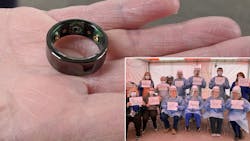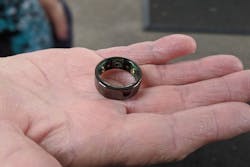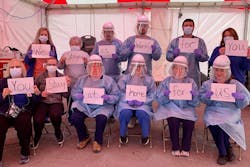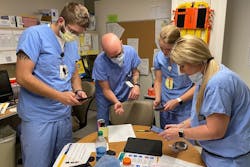Put a Ring on It: Digital PPE Pick Up Coronavirus Symptoms
Frontline workers in the coronavirus fight will soon be able to detect their own symptoms and contagiousness, thanks to wearable smart ring technology that measures body temperature and physical warning signs.
A national study, launched by the West Virginia University Rockefeller Neuroscience Institute (RNI), WVU Medicine and smart ring maker Oura Health, aims to accelerate early detection of the COVID-19 virus symptoms and contagiousness.
Leveraging an artificial intelligence-driven predictive model, wearable technology and a COVID-19 monitoring app, scientists can identify infected frontline healthcare professionals before they become symptomatic.
The clinical trial is seen as a possible breakthrough in monitoring capabilities and limiting the spread of COVID-19. According to the report, the technology measures the onset of increased body temperature and physical symptoms in real time, and also integrates physiological measures with psychological, cognitive and behavioral biometrics, such as stress and anxiety.
The researchers describe the approach as a comprehensive assessment, “tracking the mind-body connection and homeostasis in the context of asymptomatic infection.” An analysis of a frontline worker’s vital statistics is used to forecast and predict the onset of fever, cough, fatigue and other physical symptoms linked to viral infections.
Dr. Ali Rezai, executive chair of the WVU Rockefeller Neuroscience Institute, said the AI-driven models are currently predicting symptoms 24 hours prior to onset, and the researchers are working toward a three-plus-day forecast. “This forecasting capability will help us get ahead of this pandemic; limit the spread to protect healthcare workers, their families and our communities; and improve our understanding of health recovery,” said Rezai.
The biometric titanium ring is lightweight and water resistant. It comes packed with infrared LEDs, NTC temperature sensors, an accelerometer and a gyroscope to capture heart rate, heart rate variability (HRV), temperature and steps. The ring stays charged for seven days.
The Oura rings, which work in tandem with the RNI COVID-19 monitoring smartphone app, have been deployed to physicians, nurses and other frontline healthcare workers in West Virginia’s emergency departments, ICUs, testing sites and urgent-care settings. In addition, the RNI is partnering with hospitals across the United States—including those in New York City, Philadelphia, Nashville and other critical emerging areas—to monitor more than 1,000 frontline healthcare personnel with exposure to COVID-19.
About the Author

Rehana Begg
Editor-in-Chief, Machine Design
As Machine Design’s content lead, Rehana Begg is tasked with elevating the voice of the design and multi-disciplinary engineer in the face of digital transformation and engineering innovation. Begg has more than 24 years of editorial experience and has spent the past decade in the trenches of industrial manufacturing, focusing on new technologies, manufacturing innovation and business. Her B2B career has taken her from corporate boardrooms to plant floors and underground mining stopes, covering everything from automation & IIoT, robotics, mechanical design and additive manufacturing to plant operations, maintenance, reliability and continuous improvement. Begg holds an MBA, a Master of Journalism degree, and a BA (Hons.) in Political Science. She is committed to lifelong learning and feeds her passion for innovation in publishing, transparent science and clear communication by attending relevant conferences and seminars/workshops.
Follow Rehana Begg via the following social media handles:
X: @rehanabegg
LinkedIn: @rehanabegg and @MachineDesign



